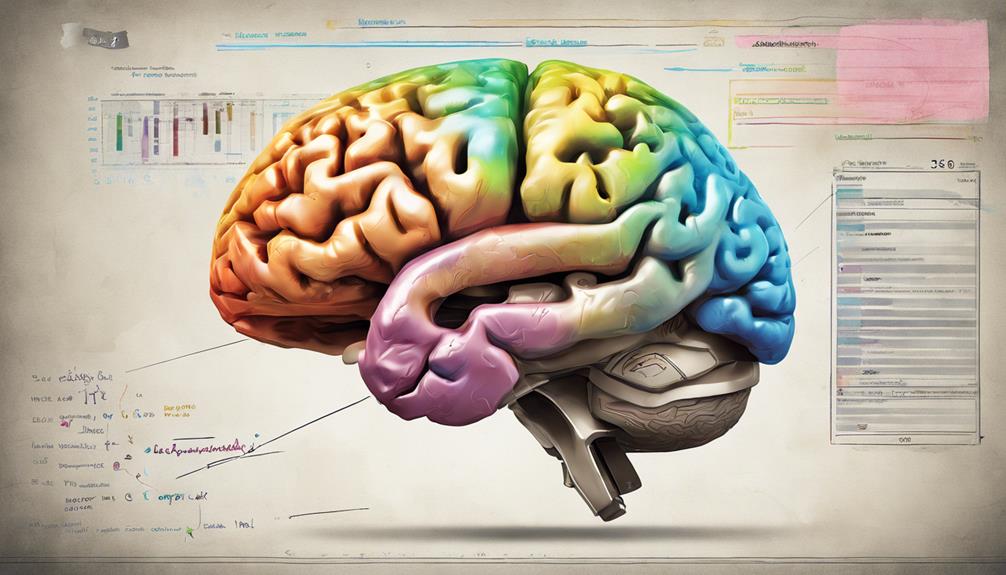Personal Goal Tracking
The Science Behind Effective Goal Tracking!
Intrigued by the neuroscience of goal tracking? Uncover how dopamine, visuals, and brain functions collaborate for successful goal pursuit!
Discover the neuroscience and psychology behind effective goal tracking. Dopamine drives motivation; visuals sustain it. Different brain parts collaborate in pursuing goals. Monitoring progress boosts drive and accountability. Cultivating a motivational culture enhances teamwork. CEOs and fitness buffs see success through tracking. Specific, measurable goals enhance achievement. Utilize tools for efficient progress monitoring. Dopamine impacts goal attainment. Create action plans and visualize progress for motivation. Understanding brain functions is key to successful goal tracking. Want to know more about releasing your full potential?
Key Takeaways
- Dopamine plays a key role in motivation and pleasure, essential for effective goal tracking.
- Visualization techniques help maintain healthy dopamine levels crucial for sustained goal pursuit.
- Clear and specific milestones enhance accountability and motivation in goal tracking.
- Tracking progress boosts self-confidence and reinforces positive behaviors for goal achievement.
- Monitoring and analyzing data consistently are vital for achieving desired outcomes in goal tracking.
Neuroscience of Goal Setting

Understanding the neuroscience of goal setting is fundamental for optimizing your motivation and achieving success. Dopamine, a key player in the brain's reward system, is crucial for driving you towards your goals. It influences neuron signal transmission essential for motivation and pleasure, making it a cornerstone in goal pursuit.
Brain regions like the amygdala, ventral striatum, and prefrontal cortex collaborate in setting and executing goals, showcasing the intricate neural processes involved. When dopamine levels are low, your ability to pursue and achieve goals may be hindered. However, employing strategies such as visualization techniques can help maintain a healthy dopamine flow, enhancing your goal-directed behavior.
Additionally, dopamine depletion can impact how the brain allocates responses, potentially affecting your focus on goal attainment. Furthermore, the body's perception of space also plays a role in evaluating goal progress and triggering dopamine release during the pursuit of your objectives.
Psychology of Goal Tracking
You understand the importance of monitoring your progress towards achieving your goals, as it helps you stay motivated and focused.
By tracking your behavior patterns, you can identify what strategies work best for you and make necessary adjustments along the way.
Visualizing your goal achievement through consistent tracking reinforces positive behaviors and boosts your confidence in your ability to succeed.
Goal Progress Monitoring
By regularly monitoring your progress towards your goals, you can increase accountability and motivation, ultimately enhancing your chances of successful goal achievement. Research indicates that individuals who actively track their progress are more likely to reach their goals successfully.
Monitoring progress not only provides a sense of accomplishment but also boosts self-confidence. It allows you to identify obstacles, make necessary adjustments, and stay on track towards goal completion. Setting specific milestones is essential in effective goal tracking.
Utilizing tools such as goal-tracking apps or journals can help you monitor your progress more efficiently. Additionally, celebrating small victories along the way can further motivate you to continue working towards your goals.
Tracking Behavior Patterns
Monitoring behavior patterns is a key aspect of goal tracking in psychology, allowing you to assess progress towards achieving your set goals. By tracking how your behaviors align with your objectives, you can identify areas for improvement and fine-tune your strategies for goal attainment.
Research indicates that individuals who monitor their progress are more likely to successfully achieve their goals than those who do not. This monitoring provides valuable feedback, increases your sense of accountability, and boosts motivation to stay focused on your targets.
Utilizing tools like apps or journals for goal tracking can enhance your self-awareness and help drive consistent progress towards your goals. By paying attention to your behavior patterns and making adjustments as needed, you can optimize your path towards goal achievement and maintain the momentum needed to reach your desired outcomes.
Visualizing Goal Achievement
The psychology of goal tracking explores the power of visualizing goal achievement to enhance motivation and focus. Visualization and mental imagery play pivotal roles in boosting goal commitment.
When you visualize yourself successfully reaching your goals, your brain activates the same areas as if you were actually performing the task. This activation not only motivates you but also improves your self-confidence and belief in achieving the desired outcomes.
Studies have shown that incorporating mental imagery into goal tracking can increase your commitment to your goals and enhance your persistence in pursuing them. The brain's inability to distinguish between imagined and real experiences makes visualization a potent tool for goal tracking.
Impact on Culture

Tracking and achieving goals within a culture can greatly influence team dynamics and performance. Setting clear goals not only motivates individuals but also unites teams towards a common purpose. When everyone understands the objectives and is aligned in their pursuit, motivation levels soar.
By providing the necessary tools and resources, you empower your team to work towards goal achievement with confidence. Breaking down these goals into smaller, achievable milestones can help prevent feeling overwhelmed and increase progress. This approach not only boosts motivation but also instills a sense of belief in the team's capabilities.
Encouraging a culture of collaboration among team members enhances communication, idea sharing, and collective problem-solving, ultimately accelerating goal achievement. When team members collaborate effectively, they not only support one another but also leverage each other's strengths to drive success.
Cultivating a culture that values motivation, goal setting, and team collaboration can lead to improved performance and a more cohesive team dynamic.
Real-World Applications

You can apply the science of effective goal tracking in real-world scenarios to see tangible results. By setting written goals and tracking progress using specific metrics, you can boost your motivation and focus.
Real-world success stories often highlight the power of goal setting and tracking in achieving remarkable outcomes.
Practical Applications
Entrepreneurs, fitness enthusiasts, students, and successful CEOs all find practical value in actively tracking and monitoring their goals for increased accountability and motivation.
Studies consistently show that tracking progress on written goals helps us stay focused and committed to our objectives.
Entrepreneurs, for instance, rely on goal tracking to achieve business milestones, guiding them towards success.
Fitness enthusiasts benefit greatly from tracking their fitness goals, as it allows them to measure their progress, stay motivated, and make necessary adjustments to their routines.
Similarly, students who keep track of their educational goals witness academic improvements through increased dedication and organization.
Successful CEOs credit their achievements in business to consistent goal tracking, emphasizing the importance of monitoring progress to ensure strategic alignment and continuous improvement.
Tangible Results
Utilizing effective goal tracking strategies in your daily life can lead to tangible results that pave the way for personal and professional success. Studies have shown that incorporating goal tracking into your routine can greatly boost your motivation to pursue and achieve your objectives. By actively monitoring your progress, you're more likely to stay focused and committed to reaching your goals.
Entrepreneurs who implement goal tracking tools report increased productivity and a higher rate of goal achievement. This psychological aspect of goal tracking plays an essential role in driving individuals towards success. The discipline and structure provided by goal tracking methods help individuals maintain consistency and momentum in their pursuits.
Goal tracking apps and systems serve as valuable resources in keeping users accountable and on track. Successful individuals attribute their accomplishments to the clarity and direction that goal tracking provides. By tracking your goals consistently, you create a roadmap to success and enhance your chances of turning your aspirations into reality.
Success Stories

Among those who've implemented effective goal tracking methods, numerous success stories have emerged, demonstrating the tangible benefits of this practice across various domains.
Successful CEOs credit their achievements to the meticulous tracking of their goals, enabling them to steer their companies towards success.
Fitness enthusiasts have witnessed remarkable progress by diligently monitoring their fitness goals, leading to improved health and well-being.
Students who consistently track their academic goals have shown higher academic performance, highlighting the positive impact of goal tracking on educational outcomes.
In different fields, high achievers attribute their success to the discipline of setting, monitoring, and achieving goals.
Case Studies

Case Study Results provide valuable insights into the impact of written goals on achievement.
Application Examples showcase how goal tracking can be applied in real-life scenarios for success.
Success Stories highlight the effectiveness of goal tracking in various aspects of personal and professional life.
Case Study Results
Case studies reveal the significant impact of tracking progress towards goals on accountability and motivation. Successful CEOs attribute a large part of their achievements to consistently tracking progress towards their goals. This practice not only helps them stay focused but also holds them accountable for their actions and decisions.
Additionally, studies show that fitness enthusiasts who track their fitness goals are more likely to see tangible progress and maintain their motivation levels over time. Similarly, students who regularly track their academic goals tend to perform better in their studies. By monitoring their progress and adjusting their strategies as needed, students can stay on track and achieve their desired academic outcomes.
Written case studies provide concrete examples of how goal tracking can effectively lead individuals towards achieving their personal and professional aspirations.
Application Examples
Successful individuals across various fields have demonstrated the power of actively tracking their goals through real-world application examples.
For instance, a study published in the Journal of Experimental Psychology highlighted that setting realistic expectations and breaking them down into smaller milestones can greatly enhance goal achievement. CEOs who maintained written goal tracking systems reported substantial contributions to their success.
Additionally, fitness enthusiasts who diligently tracked their goals in a journal experienced a remarkable 42% increase in goal attainment compared to their counterparts who didn't track progress. Similarly, students who implemented a goal tracking system witnessed a 30% improvement in their academic performance.
Entrepreneurs who consistently monitored their business goals also reaped the benefits, reporting a 65% higher success rate than those who didn't track their objectives. These real-world examples underscore the effectiveness of goal tracking in various aspects of life, emphasizing the importance of setting clear goals and monitoring progress towards them diligently.
Success Stories
High-achievers across various fields have exemplified the impact of diligent goal tracking through compelling success stories. Successful CEOs credit their accomplishments to meticulous goal tracking practices. By consistently monitoring their progress, fitness enthusiasts witness remarkable results in their fitness journeys.
Students who uphold a detailed goal tracking system often excel academically, showcasing the power of tracking goals. Furthermore, writing down goals and monitoring progress is a common strategy among high achievers in diverse professions. These success stories highlight how goal tracking aids individuals in staying accountable, motivated, and focused on achieving their desired outcomes.
- CEOs attribute achievements to diligent goal tracking practices.
- Fitness enthusiasts see better results in their fitness journeys through consistent progress tracking.
- Students performing better academically with a detailed goal tracking system.
- Writing down goals and tracking progress is a common practice among high achievers.
Research Findings

Research findings indicate that setting specific, measurable, and challenging goals leads to improved performance and goal achievement. The Psychology of Goal research on goal-setting reveals that when individuals set clear objectives that are quantifiable and require effort to accomplish, they're more likely to excel.
Studies highlight that regularly monitoring progress towards these objectives boosts both accountability and motivation. By tracking their goals, individuals enhance self-awareness, enabling them to adapt their strategies for better goal attainment. Effective methods for goal tracking include utilizing apps, spreadsheets, or journals to monitor progress and maintain focus on the end goal.
Research suggests that individuals who actively track their goals are more likely to succeed compared to those who don't track their progress. Incorporating specific, measurable, and challenging goals coupled with consistent tracking can boost your performance and increase the likelihood of achieving your targets.
Key Study Results

How do written goals contribute to enhancing accountability and motivation in goal tracking?
Research has shown that setting specific goals leads to higher motivation and increased chances of success. In Dr. Gail Matthews' study, participants who wrote down their goals were more likely to achieve them due to enhanced clarity and commitment.
Here are some key study results that highlight the benefits of written goals:
- Enhanced Clarity and Commitment: Writing down goals boosts clarity and commitment, making individuals more accountable for their actions.
- Increased Motivation: Written goals serve as powerful reminders, keeping individuals motivated to work towards their objectives.
- Improved Progress Tracking: Tracking progress becomes more manageable with written goals, leading to better accountability and goal achievement.
- Success Stories: Successful CEOs attribute their accomplishments to the habit of writing down business goals, showcasing the effectiveness of this practice.
Strategies for Success

To maximize goal achievement, implementing effective strategies for tracking progress is key in maintaining accountability and motivation.
Utilize tools like habit trackers, goal-setting apps, and spreadsheets to monitor progress efficiently.
Regularly review and adjust goals based on tracking data to improve goal-setting success.
Visualize your progress through charts, graphs, or logs to enhance motivation and focus on target outcomes.
Tracking metrics such as completion rates, time spent, and milestones reached provide valuable feedback for goal refinement.
By actively tracking your goals and progress, you can stay on course and make necessary adjustments to guarantee success.
Remember, consistency in tracking and analyzing your data is essential for achieving your desired outcomes.
Stay committed to your goals, track your progress diligently, and be open to adapting your strategies based on the insights gained from tracking to maximize your chances of success.
Brain Functions and Goal Attainment

Understanding the brain functions involved in goal attainment is fundamental for optimizing your goal-setting process and increasing your chances of success. Several key brain areas play significant roles in setting and achieving goals, such as the amygdala, ventral striatum, lateral prefrontal cortex, and orbital prefrontal cortex.
Dopamine, a neurotransmitter essential for motivation and pleasure, is particularly important in goal pursuit as it influences neuron signal transmission. Maintaining adequate dopamine levels is crucial for effectively pursuing and achieving your goals. Strategies like visualization techniques and creating specific action plans can help sustain dopamine flow, enhancing your ability to stay motivated and focused on your objectives.
Additionally, the perception of space, encompassing peri-personal and extra-personal spaces, can impact how you assess your progress towards your goals and influence dopamine release. By understanding these brain functions and incorporating effective techniques, you can optimize your goal attainment process and boost your success rate.
Frequently Asked Questions
What Is the Science Behind Goal Tracking?
To understand the science behind goal tracking, you should know that monitoring progress with quantifiable data boosts achievement rates. Tracking maintains focus, enhances motivation, and allows for necessary adjustments. Technology tools aid in efficient tracking. Goal tracking benefits also include providing a sense of accomplishment as milestones are reached, and can help identify areas where improvement is needed. Additionally, goal tracking allows for better time management and can help individuals prioritize their tasks to achieve their goals in a more organized and effective manner. Overall, the practice of goal tracking can significantly improve an individual’s ability to reach their desired objectives.
What Is the Psychology Behind Goal Setting?
Understand the psychology behind goal setting. Achieve success by crafting SMART goals. Shape self-perception, boost predictability, and add meaning to actions. Work with willingness, introspection, and realistic expectations. Emphasize ambitious yet attainable goals for best results.
What Is the Science Behind Writing Down Goals?
When you write down your goals, you enhance clarity, commitment, and increase the likelihood of achieving them. Tracking progress becomes seamless, providing a visual reminder of what needs to be done, boosting motivation and accountability.
What Is Locke's Goal Setting Theory?
You know Locke's Goal Setting Theory is about setting specific, challenging goals for better performance. It emphasizes clear, measurable goals to boost motivation and effort. Feedback and task complexity play an essential role in goal achievement.
Conclusion
To sum up, tracking your goals is essential for achieving success. Just like Sarah, a busy working mom who used a goal tracking app to lose 20 pounds and improve her overall health.
By setting specific targets, monitoring progress, and adjusting her approach as needed, she was able to reach her goals and transform her life.
Remember, with dedication and the right tools, you can turn your dreams into reality too!
Personal Goal Tracking
From Paper to Pixels: Migrating Legacy Journals Into Digital Trackers
How to seamlessly convert your legacy journals into digital trackers while ensuring accuracy and long-term security? Keep reading to discover the essential steps.

To migrate legacy journals into digital trackers, start by evaluating the volume, formats, and quality of your records. Choose appropriate OCR tools and software that support bulk uploads, automation, and robust search features. Develop a clear workflow, maintain detailed logs, and verify data accuracy throughout the process. Implement regular backups and update your digital archives to ensure long-term preservation. Keep exploring to discover how to streamline each step efficiently and securely.
Key Takeaways
- Assess the volume, formats, and quality of legacy journals to determine suitable digitization solutions.
- Utilize OCR technology for converting handwritten or printed journals into editable digital formats.
- Implement metadata standards for effective categorization, indexing, and easy retrieval of digital records.
- Choose specialized tools supporting bulk uploads, automation, and secure access to enhance migration efficiency.
- Establish ongoing digital archiving practices with regular backups and detailed documentation for data integrity.

Migrating legacy journals into digital trackers is essential for modernizing record management and improving accessibility. When you transition from paper to pixels, you open the ability to search, analyze, and share your data instantly, streamlining operations and reducing physical storage needs. Digital archiving plays a vital role in this process, guaranteeing your historical records are preserved securely while becoming easily retrievable. To succeed, you need effective data migration strategies that minimize errors and data loss during the changeover. These strategies involve careful planning, choosing the right tools, and establishing clear workflows to handle diverse formats and document types.
First, you should assess the scope of your legacy journals, identifying the volume, formats, and quality of your records. This step helps determine the appropriate digital archiving solutions and migration techniques. For example, if your journals are handwritten or printed, you might need OCR (Optical Character Recognition) technology to convert images into searchable text. When you implement digital archiving, you also establish metadata standards to categorize and index your records, making future retrieval seamless. Your data migration strategies should include testing small batches first, to identify potential issues and refine your approach before scaling up. This phased approach reduces risk and guarantees data integrity throughout the process.
Additionally, understanding the importance of specialized tools can significantly enhance the accuracy and efficiency of your migration, especially when dealing with complex or large datasets. You’ll also want to select suitable software or platforms that suit your specific needs. Look for solutions that support bulk uploads, offer robust search capabilities, and provide secure access controls. As you migrate, consistency is key. Maintain a detailed log of your data transfer process, noting any adjustments or corrections needed, to guarantee transparency and accountability. Automating parts of the migration can save time and reduce human error, but always verify migrated data against original records to catch discrepancies early. Once the migration is complete, invest in ongoing digital archiving practices, such as regular backups and updates, to protect your digital records over time.
Frequently Asked Questions
How Long Does the Migration Process Typically Take?
The migration process duration varies depending on the size and complexity of your journals. Typically, the migration timeline can range from a few days to several weeks. You’ll want to plan for the process duration to include data transfer, validation, and testing. Keep in mind that thorough planning and clear communication with your team can help streamline the process, ensuring a smoother progression and minimizing downtime.
What Are the Costs Involved in Digital Migration?
You should conduct a thorough cost analysis to understand the expenses involved in digital migration. Costs can include software licenses, data transfer, staff training, and ongoing maintenance. By doing so, you can plan your budget effectively and avoid surprises. Budget planning guarantees you allocate sufficient resources upfront, making the migration smoother and more cost-efficient. Keep track of all potential costs to make certain of a successful shift without overspending.
How Is Data Privacy Ensured During Migration?
You guarantee data privacy during migration by implementing strong encryption protocols to protect your information in transit and at rest. You also control access through strict access controls, limiting who can view or modify the data. By continuously monitoring the process and using secure authentication methods, you reduce the risk of breaches, making certain your legacy journal data stays private throughout the digital transition.
Can Legacy Journals Be Migrated Incrementally?
You can definitely migrate legacy journals incrementally, which helps you manage formatting challenges more smoothly. This approach allows you to address potential issues step by step, ensuring a seamless changeover. Plus, it offers time to provide user training, so your team adapts comfortably. By pacing the migration, you minimize disruptions, making the entire process more efficient and less overwhelming for everyone involved.
What Are Common Challenges Faced During Migration?
When you migrate legacy journals, you often face challenges like ensuring metadata accuracy, which is vital for searchability and organization. Format compatibility can also be tricky, especially if older files don’t align with new digital tracker requirements. You might encounter data loss or corruption if the migration isn’t carefully managed. Addressing these issues early helps you maintain data integrity and achieves a smoother shift to digital formats.
Conclusion
By migrating legacy journals into digital trackers, you not only preserve valuable research but also unlock the potential for new discoveries. Some believe digital transformation accelerates innovation, and evidence suggests it does, enabling faster access and collaboration. So, as you digitize these archives, remember you’re not just modernizing—you’re possibly validating the theory that technology fuels scientific progress. Embrace this change, and you could be shaping the future of research itself.
Personal Goal Tracking
Celebration Systems: Rewarding Milestones Without Breaking the Bank
Discover affordable celebration systems that make rewarding milestones impactful and memorable without overspending, ensuring your recognition programs truly resonate.

You can celebrate milestones effectively without spending a lot by focusing on personalized recognition and simple gestures. Public praise, heartfelt thank-you notes, or customized awards make moments memorable without breaking the bank. Peer recognition programs and highlighting achievements via newsletters also boost morale. Keep the focus on meaningful, genuine appreciation tailored to individual preferences—it creates lasting impact. Want to discover more ways to make every milestone special on a budget?
Key Takeaways
- Use personalized recognition like handwritten notes or certificates to make milestones meaningful without high costs.
- Highlight achievements publicly in meetings or newsletters to celebrate success affordably.
- Implement peer recognition programs to foster a supportive culture with minimal expenses.
- Focus on heartfelt, sincere celebrations that emphasize genuine appreciation over monetary rewards.
- Leverage existing communication channels to acknowledge milestones creatively and cost-effectively.

Have you ever wondered how organizations create memorable moments during their special events? The secret often lies in effective celebration systems that emphasize meaningful recognition without overspending. You don’t need a hefty budget to make employees or team members feel valued; instead, you can focus on delivering cost effective rewards that resonate. The key is to offer personalized recognition that aligns with individual preferences and achievements, making each celebration feel genuine and impactful.
Creating memorable celebrations with meaningful, personalized recognition—without overspending or breaking the budget.
When designing a celebration system, think beyond material gifts. Personalized recognition can take many forms, from a heartfelt thank-you note to tailored acknowledgment of specific accomplishments. These touches show you genuinely appreciate your team’s efforts, which boosts morale and fosters loyalty. Cost effective rewards don’t have to be expensive—they can include public praise during meetings, customized certificates, or small tokens that hold personal significance. The goal is to make each reward feel special without draining your resources.
Incorporating personalized recognition into your celebration system is about understanding what motivates your team members. Some may value public acknowledgment, while others might prefer a private note or a personalized message. Take the time to get to know what makes your employees feel appreciated, and then craft your rewards accordingly. This approach not only makes the recognition more meaningful but also demonstrates that you’re attentive to individual preferences, which deepens engagement.
Creating memorable moments with a limited budget is entirely possible when you focus on the quality of recognition rather than its cost. Simple gestures like highlighting achievements in newsletters or during team meetings can have a significant impact. You might also consider peer-to-peer recognition programs, where colleagues acknowledge each other’s contributions. These systems are highly cost-effective and promote a positive, supportive culture. When recognition feels authentic and personalized, it becomes a powerful motivator that encourages continued excellence.
Ultimately, a well-thought-out celebration system emphasizes thoughtful, personalized recognition over expensive rewards. It’s about celebrating milestones in a way that feels sincere and motivating. By focusing on cost effective rewards that are tailored to individual preferences, you create a culture where everyone feels appreciated and motivated to excel. Small, meaningful gestures can leave lasting impressions, turning ordinary moments into memorable milestones. When your celebration system prioritizes authentic recognition, you foster a positive environment that celebrates growth, achievement, and connection—all without breaking the bank. Additionally, leveraging cost-effective methods such as peer recognition can significantly enhance your program’s impact.
Frequently Asked Questions
How Can Small Businesses Implement Affordable Celebration Systems Effectively?
You can implement affordable celebration systems by focusing on employee recognition and smart budget planning. Recognize achievements with simple gestures like personalized thank-you notes or shout-outs during team meetings. Set aside a small, dedicated budget for celebrations, ensuring it’s consistent but manageable. This way, you foster a positive environment, motivate your team, and celebrate milestones without overspending. Keep it genuine and frequent to maximize impact without breaking the bank.
What Are Creative Ways to Celebrate Milestones on a Tight Budget?
Oh, sure, celebrating milestones on a tight budget sounds as easy as throwing confetti in a tornado. But fear not! You can use cost-effective ideas like personalized praise, social media shoutouts, or homemade awards. Get creative celebration techniques by hosting themed virtual parties or offering handwritten notes. With a bit of humor and ingenuity, you turn simple gestures into memorable moments, proving that celebration doesn’t have to drain your wallet.
How Do Celebration Systems Impact Employee Motivation and Retention?
You’ll find that effective celebration systems boost employee engagement and strengthen recognition strategies, leading to higher motivation and retention. When you recognize achievements, employees feel valued and appreciated, fostering loyalty. By implementing thoughtful, budget-friendly recognition methods, you create a positive work environment where employees stay committed. These systems show your team you care, which encourages ongoing effort and reduces turnover, ultimately benefiting your organization’s long-term success.
Are Digital or Virtual Celebration Systems Cost-Effective Options?
You might think virtual badges and digital rewards are costly, but they’re actually very cost-effective. Virtual badges recognize achievements without extra expenses, and digital rewards reduce costs associated with physical prizes or events. These systems save money while still fostering motivation and engagement. Plus, virtual platforms are easy to implement and scale, making them a smart choice for companies looking to reward milestones without overspending.
What Are Common Pitfalls to Avoid When Designing a Celebration System?
When designing a celebration system, you should watch out for common pitfalls like misaligned incentives and inconsistent recognition. If your system rewards only certain achievements or is unclear, people may feel discouraged or confused. To avoid this, guarantee your recognition is fair, transparent, and aligns with your team’s goals. Consistent acknowledgment keeps motivation high and prevents feelings of favoritism, making your celebration system both effective and inclusive.
Conclusion
By implementing creative and budget-friendly celebration systems, you can recognize milestones without overspending. For instance, imagine rewarding your team with personalized thank-you notes and a virtual pizza party instead of costly gifts. These thoughtful gestures boost morale and foster a positive environment without breaking the bank. Remember, celebrating achievements doesn’t have to be expensive—it’s the genuine appreciation that counts. Start small, get creative, and watch your celebrations inspire continued success!
Personal Goal Tracking
Goal Fatigue: Recognize It Before It Derails You
Inevitably, goal fatigue can sneak up on you, but recognizing the signs early can mean the difference between success and setback.

You might start feeling less motivated, overwhelmed, or drained without realizing it’s goal fatigue setting in. Signs include struggling to stay focused, procrastinating, or feeling like your efforts aren’t paying off. If you ignore these cues, your progress stalls, and goals seem more distant. Recognizing early warning signs and adjusting your approach can help you maintain momentum. Keep going, and you’ll discover practical ways to stay on track before fatigue takes over.
Key Takeaways
- Monitor signs like decreased motivation, feeling overwhelmed, or procrastination to catch goal fatigue early.
- Break large goals into smaller, manageable steps to prevent burnout and maintain momentum.
- Regularly reassess your goals to ensure they align with your values and current energy levels.
- Celebrate small wins to boost motivation and reinforce progress.
- Prioritize well-being and take proactive breaks to sustain energy and prevent emotional exhaustion.

Have you ever felt overwhelmed or drained after setting and pursuing multiple goals? That’s a common experience, especially when you’re juggling several ambitions at once. You start with enthusiasm, but as time goes on, motivation dips, and progress stalls. It’s frustrating to put in effort and see little to no results, making it harder to stay committed. This phenomenon, often called goal fatigue, can quietly creep in, undermining your motivation and throwing your plans off course. Recognizing it early is key to preventing it from derailing your progress altogether.
Feeling overwhelmed or drained? Recognize goal fatigue early to stay motivated and keep your progress on track.
When motivation dips, it’s easy to fall into a cycle of self-doubt and procrastination. You might tell yourself that you’re not cut out for your goals or that the effort is too much. But more often than not, this is just a sign that your energy reserves are running low or that your goals need recalibration. If you ignore these signs, your progress stalls completely. You stop taking consistent action, and what once felt exciting becomes a chore. Without awareness, goal fatigue can become a persistent barrier, sapping your enthusiasm and making your goals feel distant or unachievable.
To combat this, you need to tune into your internal state regularly. Ask yourself what’s draining your energy—are you overwhelmed, under-rested, or perhaps pushing yourself too hard? Sometimes, the problem isn’t your goals but how you’re approaching them. Break larger objectives into smaller, manageable steps. Celebrate small wins to boost motivation and remind yourself that progress, no matter how slow, is still progress. It’s also vital to reassess your goals periodically. Are they still aligned with your values and priorities? If not, adjusting them can reignite your passion and clear the mental clutter that fuels goal fatigue.
Another way to prevent motivation dips is to create a support system. Share your goals with friends, family, or colleagues who can hold you accountable and offer encouragement when your energy wanes. Remember, setbacks are normal; they don’t mean you’ve failed. Instead, view them as opportunities to learn and adapt. Recognizing the signs of goal fatigue early allows you to implement strategies—like taking breaks, revisiting your purpose, or adjusting your pace—before your motivation completely evaporates.
Additionally, paying attention to your physical and mental well-being is crucial, as well-being directly influences your motivation and resilience. Ultimately, goal fatigue isn’t a sign of weakness but a natural response to sustained effort. By staying aware and proactive, you can keep your momentum alive, ensuring that your goals remain motivating rather than draining. When you acknowledge the signs early and respond thoughtfully, you’re more likely to stay on track and achieve what you set out to do.
Frequently Asked Questions
How Can I Differentiate Between Goal Fatigue and Burnout?
When trying to tell goal fatigue apart from burnout, pay attention to how you feel. If your motivation dips and your focus decline only after working hard for a while, it’s likely goal fatigue. But if you feel emotionally drained, detached, or lose interest in everything, that’s burnout. Recognizing these signs helps you address the issue early, so you can adjust your approach and prevent further exhaustion.
What Are Early Signs of Goal Fatigue?
When you notice motivation dips and progress stalls, you might be experiencing early signs of goal fatigue. You could feel less excited about tasks you once enjoyed, or find it harder to stay focused. Maybe you’re questioning your efforts more often or feeling overwhelmed without a clear reason. Recognizing these subtle shifts early helps you adjust your approach, preventing exhaustion from turning into burnout and keeping your journey on track.
Can Goal Fatigue Affect Mental Health?
Goal fatigue can markedly impact your mental health, leading to feelings of burnout, frustration, or anxiety. When you’re overwhelmed by ongoing pressure, your mental health impacts worsen, making stress management more difficult. Recognizing goal fatigue early helps you address these feelings, prevent emotional exhaustion, and maintain a healthier mindset. By managing your goals realistically, you support both your mental well-being and your ability to stay motivated.
How Long Does Goal Fatigue Typically Last?
Ever wonder how long goal fatigue lasts? It varies based on your goal setting and motivation dips. Usually, it can linger from a few days to several weeks if left unchecked. You might feel drained or lose focus, but recognizing early signs helps you reset. To shorten this period, adjust your goals, celebrate small wins, and stay motivated. Don’t let fatigue stall your progress—address it before it worsens.
Are There Specific Industries More Prone to Goal Fatigue?
Certain industries, like healthcare, tech, and finance, are more prone to industry burnout and goal overload, making goal fatigue more common. You might find yourself overwhelmed more quickly in high-pressure environments where deadlines and performance targets pile up. Recognizing these industry trends helps you stay alert to signs of fatigue, so you can implement strategies to maintain motivation and avoid burnout before it hampers your progress.
Conclusion
If you ignore goal fatigue, you risk losing everything—your dreams, your passion, your very identity. It’s like running a marathon with a broken leg, pushing forward until you collapse in a heap of regret. But recognizing it early can save you from the abyss. Don’t let exhaustion steal your future. Stay aware, stay balanced, and above all, protect your fire. Because if you burn out now, you’ll never reignite the flames of your true potential.
-

 Wish Notes1 year ago
Wish Notes1 year agoBest Caption to Wish Myself a Happy Birthday That Everyone Will Like!
-

 Wish Notes1 year ago
Wish Notes1 year agoThe Best Birthday Wishes to Make Your Uncle's Day Bright!
-

 Wish Notes1 year ago
Wish Notes1 year agoThe Sweetest Happy Birthday Wishes for Your Wife!
-

 Wish Notes1 year ago
Wish Notes1 year agoThe Best Happy Birthday Wish for Your Brother That Will Make Him Smile!
-

 Wish Notes1 year ago
Wish Notes1 year agoHeartwarming Birthday Messages for Mom in Spanish
-

 Wish Notes1 year ago
Wish Notes1 year agoThe Best Happy Birthday Wishes for Your Husband That Will Make His Day!
-

 Wish Notes1 year ago
Wish Notes1 year agoThe Ultimate Birthday Wishes to Celebrate Yourself!
-

 Wish Notes1 year ago
Wish Notes1 year agoThe Most Heartfelt Good Night Wishes Ever!










